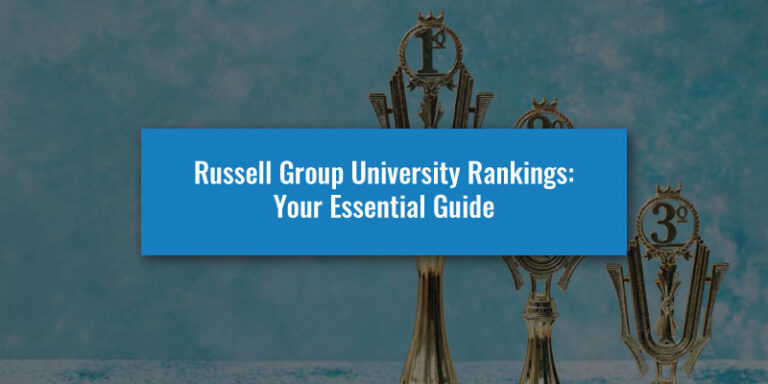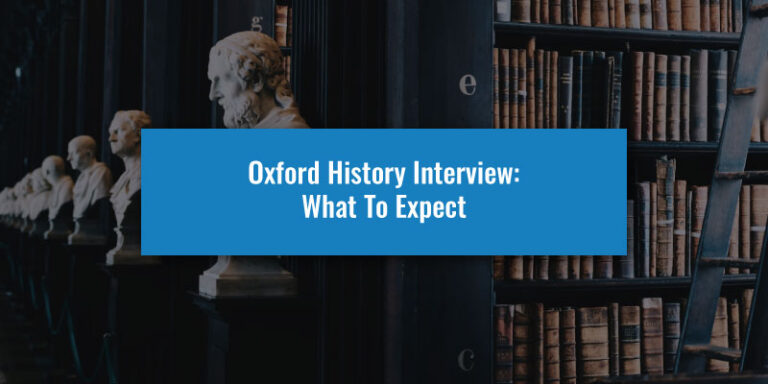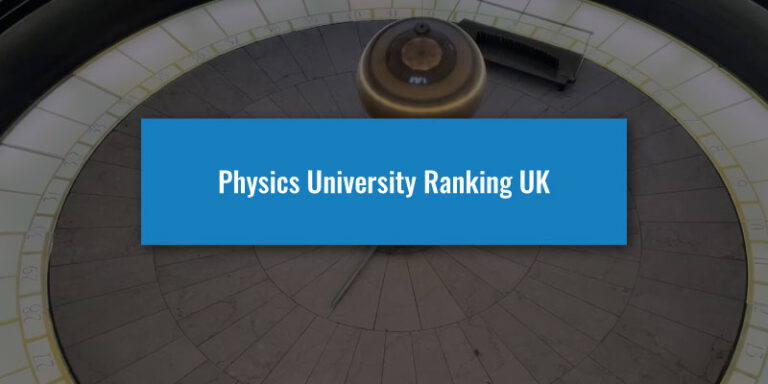Finding the right university can be difficult, especially when you’re applying for a subject that’s taught at 80+ universities in the UK. If you don’t know where to start, university rankings may be a good option.
Ranking tables are made for every major subject taught in the UK and use a wide selection of data and facts to determine which universities are the best for specific courses. However, while these tables can be useful, they aren’t perfect and shouldn’t be the only resource you use when selecting university choices.
In this guide, we’ll take a look at the two most popular ranking tables in the UK to see how each one ranks English degrees. Plus, we’ll see how rankings can be used to effectively select your preferred university through a mixture of data and subjective opinion. Let’s get started.
Who Makes The History rankings?
The first question is, “Who makes these tables?” Thankfully, this is easy to answer, although there’s not just one organisation behind it. Both nationally and internationally, there are many bodies that create these tables based on data, ranking universities either within a single country or worldwide. These lists can be based on many things, though general and subject lists are the most common.
Of the ranking tables created for UK universities, the two most popular are made by Complete University Guide and The Guardian. Both of these tables gather data from similar places, but these lists can vary greatly due to how the data is interpreted and how scores are calculated for each category.
Therefore, there’s no “definitive” list of which universities are best as the ranking tables we have are all judged in slightly different ways. To get a better understanding of what this means for the rankings, let’s look at the top 25 entries from each list to understand how they’re made and what they look like.
Want to get into History at Oxbridge? Build an amazing application with UniAdmissions
Want to study English at Oxford or Cambridge? Writing the perfect Personal Statement, scoring highly on your HAT/HAA and interviewing like a pro is how you get your dream Oxbridge History offer.
Discover our Full-Blue History Programme for comprehensive admissions support by clicking the button below to enrol and triple your chances of success.
The Guardian History Rankings
To create their History degree rankings, The Guardian uses the following headings:
Guardian score/100 – rating of excellence based on a combination of the other factors.
Satisfied with the course – the rating of the overall quality of the course, given by final-year students in the latest National Students Survey (NSS) given as a percentage.
Satisfied with the teaching – the rating of the quality of teaching on the course given by final-year students in the latest NSS.
Satisfied with feedback – the rating of the feedback and assessment, given by final-year students in the latest NSS.
Student to staff ratio – number of students per member of teaching staff.
Spend-per student/10 – money spent on each student, excluding academic staff costs, given as a rating out of ten.
Average entry tariff – typical UCAS scores of young entrants to the department.
Value-added score/10 – this score compares students’ degree results with their entry qualifications, to show how effectively they are taught – given as a score out of ten.
Career after 15 months – percentage of graduates who find graduate-level jobs, or are in further study at professional or higher education level, within 15 months of graduation.
Continuation – percentage of first-year students continuing to second-year.
The Guardian has various sources to base their scores on and create their lists, including the National Student Survey (NSS)(which collects student satisfaction data) and the information provided by universities themselves. Although a combination of subjective and objective factors is considered, the data is analyzed impartially to ensure the rankings accurately reflect the information gathered.
The Guardian History University Rankings 2025
Below are the top 25 entries of The Guardian’s league table for History, with both the results for 2025 and a comparison to 2024’s results:
| Postition | University | Previous Position (2024) |
|---|---|---|
| 1 | University of Oxford | 2 (>1) |
| 2 | University of St. Andrews | 1 (<1) |
| 3 | University of Cambridge | 3 (=) |
| 4 | London School of Economics (LSE) | 6 (>2) |
| 5 | Durham University | 5 (=) |
| 6 | University College London (UCL) | 9 (>3) |
| 7 | Teeside University | 10 (>3) |
| 8 | University of Warwick | 8 (=) |
| 9 | University of Huddersfield | 20 (>11) |
| 10 | University of Derby | 14 (>4) |
| 11 | Bournemouth University | 4 (<7) |
| 12 | University of Leicester | 30 (>18) |
| 13 | Leeds Beckett University | 15 (>2) |
| 14 | University of York | 11 (<3) |
| 15 | University of Strathclyde | 13 (<2) |
| 16 | University of Sheffield | 22 (>6) |
| 17 | University of Roehampton | 12 (<5) |
| 18 | University of Leeds | 26 (>8) |
| 19 | University of Bristol | 20 (>1) |
| 20 | University of Southampton | 25 (>5) |
| 21 | Royal Holloway, University of London | 28 (>7) |
| 22 | University of East Anglia (UEA) | 16 (<6) |
| 23 | Salford University | 53 (>30) |
| 24 | King’s College London | 19 (<5) |
| 25 | University of Manchester | 17 (<8) |
Looking at this list, there are a few notable things to mention. Starting with the top ten first, we can see many of the universities commonly considered the best in the UK, including four of the five G5 Universities (Imperial does not teach History, so is not included on the list).
Oxford scored the top spot this year, though Cambridge was overtaken by St Andrew’s in 2nd. This is sometimes considered the best university in Scotland and is often ranked above the Oxbridge universities by The Guardian.
Rounding out the rest of the top ten are a mixture of common picks (Warwick, Durham) and unis that are less commonly ranked high (Derby, Huddersfield, Teeside). This was Teeside’s second year in a row within the Top 10.
There were multiple universities that had vastly different placements compared to 2024’s list, with the top 25 also seeing the inclusion of Leicester (up 18) and Salford (up 30). These are fairly large changes, but there are also a handful of universities that fell down drastically in the rankings.
Some of 2024’s Top 25 entries have fallen below this mark, including Liverpool Hope University (down from 18th to 43rd) Aberystwyth University (down from 22nd to 30th), Ulster University (down from 22nd to 37th) and the University of Suffolk, which ranked 7th in 2024 but was not included in the 2025 table.
The Complete University Guide History Rankings
Overall score – the total score calculated by The Complete University Guide’s independent and trusted methodology.
Entry standards – the average UCAS tariff of new students entering university.
Student satisfaction – a guide to how satisfied students are with the quality of teaching they receive.
Research quality – a measure of the quality of the research undertaken by the university.
Research intensity – a measure of the proportion of staff involved in high-quality research at the university.
Graduate prospects – outcomes – a guide to the success of graduates after leaving university.
Graduate prospects – on track – a measure of whether recent graduates agree that their current activity fits with their future plans.
The Complete University Guide groups several factors into broader categories, which is why it provides fewer scores compared to The Guardian’s list. However, the data is gathered from similar sources, such as the NSS and universities, so the variations primarily arise from differences in how the data is interpreted.
Complete University Guide History University Ranking Table 2025
Below are the top 25 entries Complete University Guide History ranking table, with both the results for 2025 and the comparison to 2024’s results:
| Postition | University | Previous Position (2024) |
|---|---|---|
| 1 | University of Cambridge | 2nd (>1) |
| 2 | University of Oxford | 1st (<1) |
| 3 | University of St. Andrews | 1st (=) |
| 4 | Durham University | 4th (=) |
| 5 | London School of Economics (LSE) | 5th (=) |
| 6 | University College London (UCL) | 7th (>1) |
| 7 | University of Warwick | 6th (<1) |
| 8 | University of Exeter | 10th (>2) |
| 9 | University of York | 9th (=) |
| 10 | King’s College London | 8th (<2) |
| 11 | University of Manchester | 11th (=) |
| 12 | University of Bristol | 12th (=) |
| 13 | University of Birmingham | 14th (>1) |
| 14 | University of Leeds | 13th (<1) |
| 15 | Loughborough University | 18th (>3) |
| 16 | Lancaster University | 17th (>1) |
| 17 | University of Edinburgh | 15th (<2) |
| 18 | University of Sheffield | 20th (>2) |
| 19 | University of Nottingham | 19th (=) |
| 20 | University of Sussex | 25th (>5) |
| 21 | University of Strathclyde | 21st (=) |
| 22 | University of Southampton | 16th (<6) |
| 23 | University of Glasgow | 24th (>1) |
| 24 | University of East Anglia (UEA) | 23rd (<2) |
| 25 | Queen Mary University of London | 22nd (<3) |
This list has many similarities and differences to The Guardian’s list, so let’s unpack what we can see.
In the top ten, we find many of the same universities that The Guardian included, with just a few differences throughout. However, as we move down, we can see that there are more universities from major cities, many of which are in England. There is slightly less representation from Scotland and especially Wales, which only has one university in the top 25.
Looking at position changes, we can see that the rankings are much more stable on this list, with only a handful of significant movements. These include Sussex (up five places) and Southampton (down six places), which are very minor when compared to the The Guardian’s list.
Access "The Oxbridge Application Vault"
- 300+ page ebook for Oxbridge Applicants
- 25 page ebook for Personal Statement
- 2h+ online course to succeed in any exam
- Online Oxbridge Success Calculator
- 12 page ebook about UniAdmissions

Access "The Big Book Of Oxbridge Applications" For FREE
Want to study History at Cambridge or Oxford? Download The Big Book Of Oxbridge Applications for free here to discover everything you need to know about Oxbridge History and its application process. Through over 350 pages, you’ll find:
- Over 40 admissions test practice questions
- 28 example Oxbridge Personal Statements
- Interviews with Oxbridge students and graduates
- Additional downloadable resources
Fill in your details below to claim your digital copy today!

The Best and Worst UK Universities For History
Best UK Universities For History
As we previously discussed, the top five for both lists are very similar, but let’s break down why these universities are considered the best.
Complete University Guide
- University of Cambridge
- University of Oxford
- University of St. Andrews
- Durham University
- London School of Economics
The Guardian
- University of Oxford
- University of St. Andrews
- University of Cambridge
- London School of Economics (LSE)
- Durham University
Both lists share the same universities in the top five, though in a different order. As is standard for the core subject at UK universities, Oxford and Cambridge each appear in the top five and take first place on one of the tables. St. Andrews is another commonly high-ranking university, being considered one of the best in Scotland, and is the only non-Russell Group university on the list. It was also able to beat Cambridge in The Guardian’s ranking.
Durham and LSE are two other commonly high-ranking universities, both being a part of the traditionally high-ranking Russell Group. In the previous year, The Guardian had ranked the University of Bournemouth in the top five, but it has since been moved further down.
Overall, the rankings here aren’t too different from one another, but it’s still a good demonstration of how the data used can be interpreted differently and why these tables can’t act as a definitive ranking.

Worst UK Universities For History
Before we begin, it’s important to clarify that calling these universities the “worst” for History doesn’t necessarily mean their courses are poor. Rather, this label comes from the fact that they rank the lowest according to the criteria used by these ranking organisations.
Complete University Guide
- Bishop Grosseteste University
- University of the Highlands and Islands
- University of Westminster
- University of Wolverhampton
- Canterbury Christ Church University
The Guardian
- University of Greenwich
- University of Winchester
- University of the Highlands and Islands
- University of West England, Bristol
- Goldsmiths, University of London
While the selection of universities at the bottom of the list is pretty varied, we can see that there is one shared entry; Highlands & Islands. However, it’s very common between the two tables to have a lot of variance in their lower rankings.
None of these universities are seen as major institutions within the UK. Of these, some of the most notable are Westminster and Goldsmiths, both universities located in London.
Which Ranking Table Should I Follow?
Lastly, we should consider whether one of these rankings is more reliable than the other. Unfortunately, there isn’t a clear-cut answer, as neither table has distinct advantages or flaws over the other. While the rankings differ, these variations stem from slight differences in data interpretation and scoring rather than any inherent bias or subjective factors.
The Guardian’s ranking focuses more on the student perspective via various satisfaction ratings, while The Complete University Guide places greater emphasis on research, employment prospects, and student satisfaction. Depending on which factors matter most to you, one ranking might be more helpful than the other. However, overall, neither table is inherently superior.
For instance, if your primary focus is on objective statistics and data concerning the admissions process, you’ll want to examine the entry requirements and acceptance rates for each university you’re considering. Prestigious institutions like Oxford and Cambridge typically have very strict entry requirements and low acceptance rates (13.8% at Oxford and 16.6% at Cambridge), so it’s essential to evaluate whether your application will be competitive enough.
However, there’s more to the decision-making process than which university has the best statistics. Selecting a university should also involve a subjective component, as it’s important to ensure you will enjoy both living and studying at your chosen institution. We’d recommend attending open days they’re an excellent way to inform your decision, allowing you to explore the facilities, check out the surrounding area, and ask questions to faculty and current students.
Conclusion
This wraps up our look at History university rankings in the UK. While these tables can serve as a useful starting point for your research, it’s important to remember that they are not the sole factors to take into account. There are numerous ways to evaluate whether a university is the right choice for you, and the highest-ranked institutions may not always align with your personal preferences and needs.
While rankings provide a framework for expectations, they aren’t absolute—indeed, we’ve observed significant fluctuations from year to year! Conduct your research, visit the universities you’re interested in and remain open-minded. You’re bound to discover a university that suits you well, regardless of its ranking!
Worried about your Oxbridge chances? Our offer success rate is 59%
Applying to Oxbridge is immensely competitive and it is crucial that you give yourself the best chance of success. We help you craft the perfect Personal Statement, achieve a highly competitive HAT/HAA score and teach you how to Interview effectively – covering all areas of your Oxbridge application.
Discover our Full-Blue History Programme now to learn how you can triple your chances of success.









